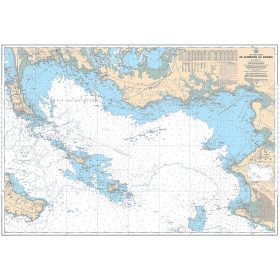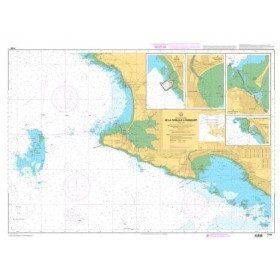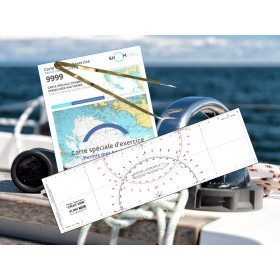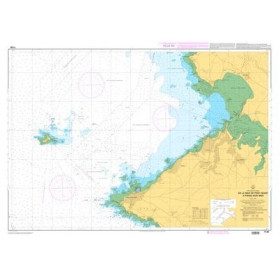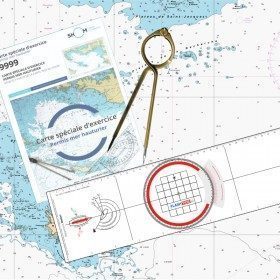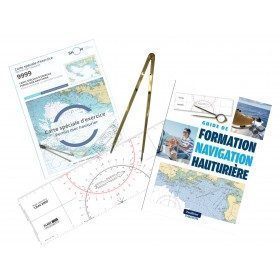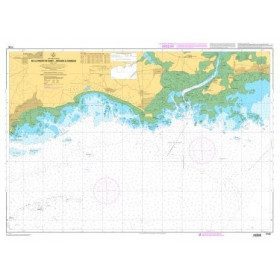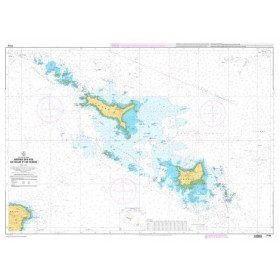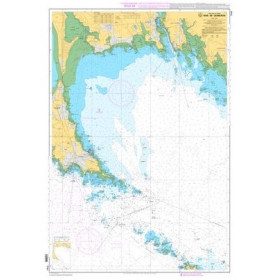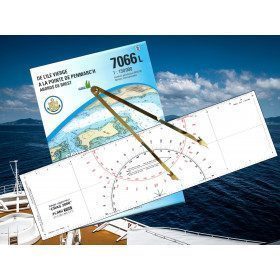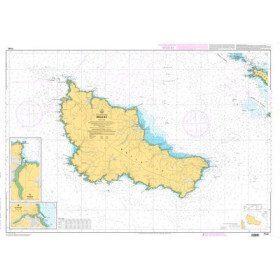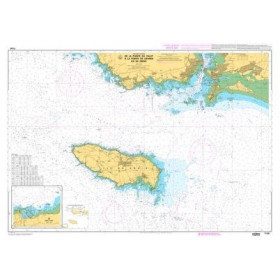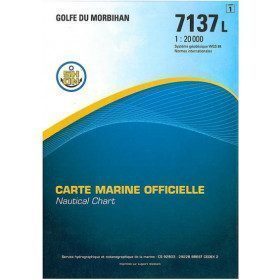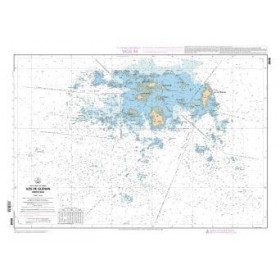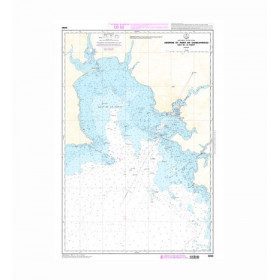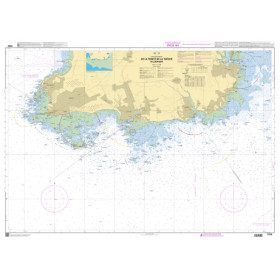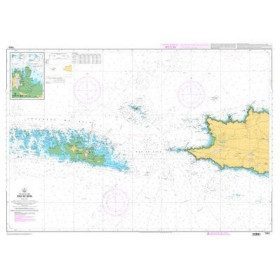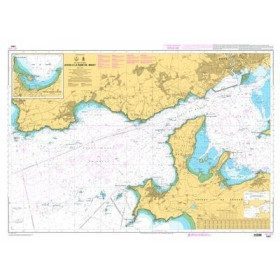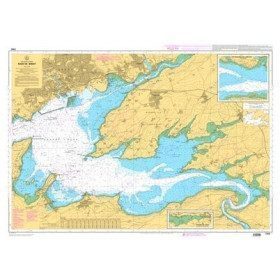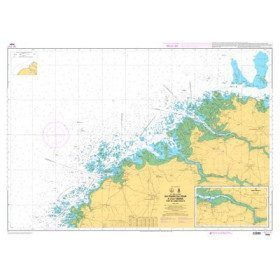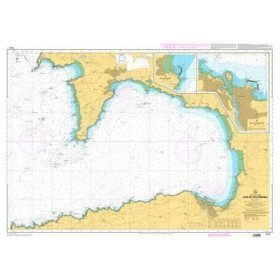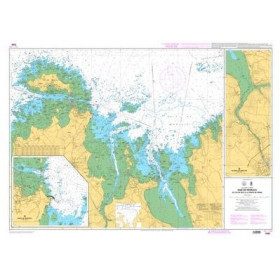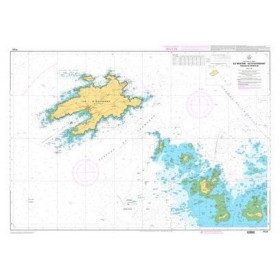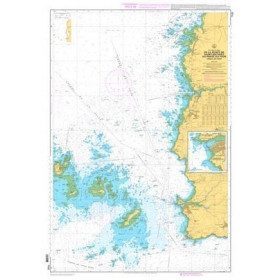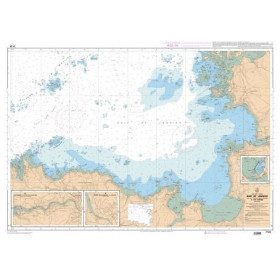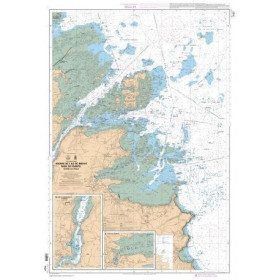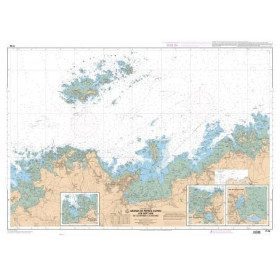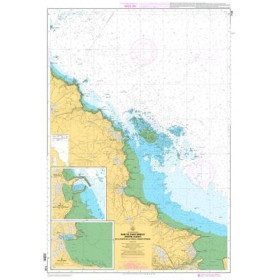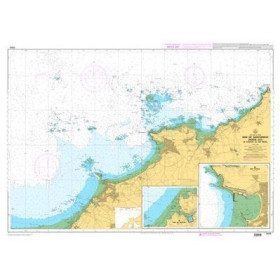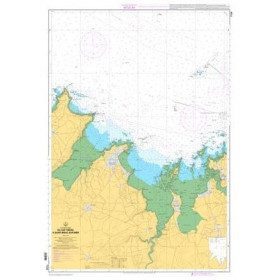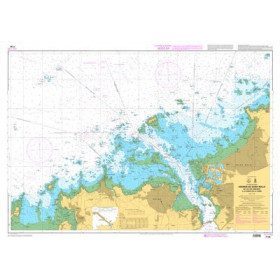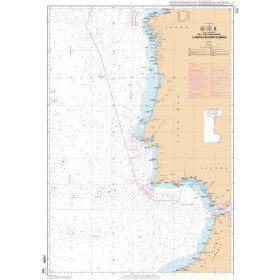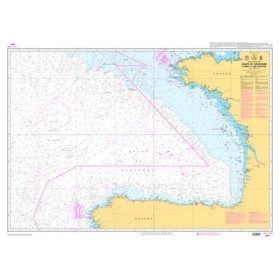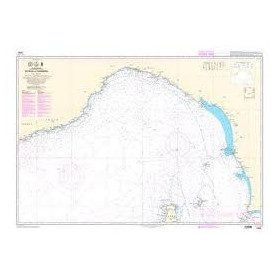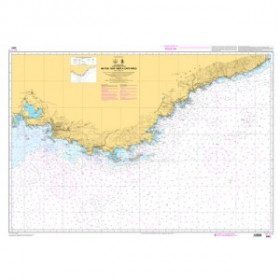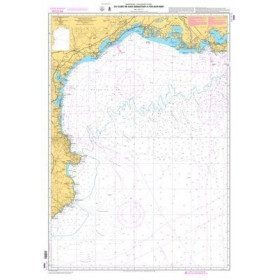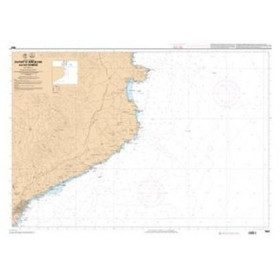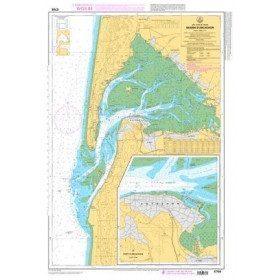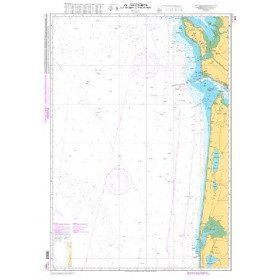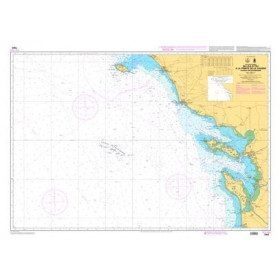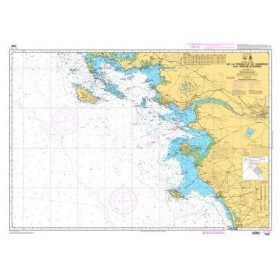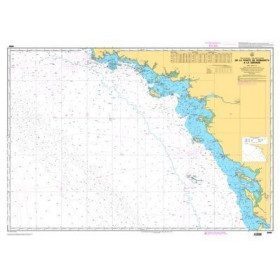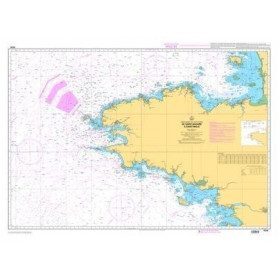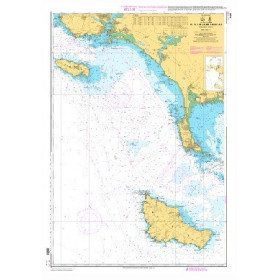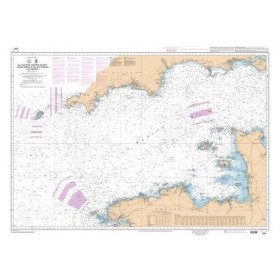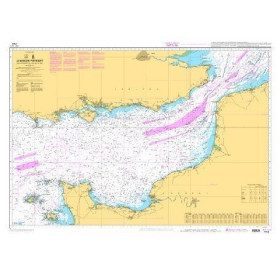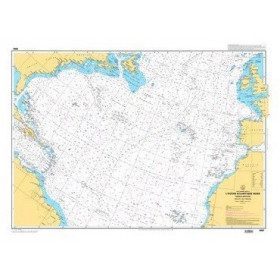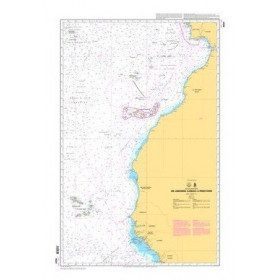
Nautical Charts
The nautical chart of your navigation area is an essential element to use on board to navigate safely. Whether you are sailing inshore or offshore, it will first help you choose the most suitable route for the forecasted conditions (weather, tides, current). Once at sea, the chart helps to monitor and manage the navigation: determine the position, note any deviations and correct the route. In "sensitive" coastal areas (rocks, sandbanks) or at the entrance to harbours, a more detailed chart gives the necessary indications to follow a safe route using buoyage or alignments: this is called coastal pilotage Mandatory on board as soon as you get to the coastal area, a chart can be in paper or electronic form, but we strongly recommend that you have both. Picksea offers two types of charts: the SHOM and the NV-Charts :
NAUTICAL CHARTS OF THE SHOM
The SHOM is the French Naval Hydrographic and Oceanographic Service. For 300 years, it is the service that establishes hydrographic surveys and publishes nautical charts for France and many areas in the World. The SHOM offers two formats of paper charts, folded charts and flat charts. The L-chart collection (folded version) is a selection of nautical charts perfectly adapted for pleasure boating. They provide boaters with exactly the same information as conventional charts and are updated at regular intervals. Picksea has a selection of the top 20 best selling and most popular L SHOM navigation charts used by boaters as well as the charts dedicated to the SHOM dedicated to exams pleasure Craft (Offshore licence) or merchant marine. The SHOM also offers a number of "flat" charts that can be delivered rolled.
NAUTICAL CHARTS PACKS NV-CHARTS
NV-Charts is a German publisher who has designed and developed a concept of chart packs combining the traditional paper form with modern electronics. The concept is to propose for a navigation area (for example "from Lorient to Noirmoutier" or "from Toulon to Menton") in the same pack the paper charts at different scales (from the map of the covered area to the detailed maps of the ports) and the same charts in electronic format that it is possible to use with the NVapp application, i.e. the navigation software of NV-Charts whose standard version (sufficient for yachting) is free and usable on any support (Windows, Android, MacOS or Iphone).
AREAS COVERED BY THE OFFER PICKSEA
Picksea offers you a choice of nautical charts for the whole world thanks to its quality of Authorized Agent of SHOM. Find all the charts at different scales for the areas of English Channel, the North Brittany and South Brittanyand atlantic coast, the Mediterranean or the overseas areas.
Read more
There are 135 products.
-
<h2 style="text-align:justify;">SHOM chart 9999 for the french offshore licence exam</h2>
<p style="text-align:justify;">The SHOM chart 9999 is the official chart for the offshore licence examination which allows you to navigate beyond 6 miles from a shelter. The 9999 chart is also used to do all the exercises to prepare for the exam.</p>
<h2 style="text-align:justify;">Training and preparation for the french offshore licence (theory test)</h2>
<p style="text-align:justify;">After passing the coastal licence (and perhaps also the inland waterway licence), you want to extend your navigation area to the "high seas"! To do this, you need to obtain a offshore licence to sail motorboats beyond 6 miles from a shelter (it is also very useful for sailing boats). You can read the article <a href="https://www.picksea.com/en/actualites-et-conseils/post/18-all-knowing-pass-license-holder">"Everything you need to know about the offshore licence"</a>.</p>
<p style="text-align:justify;">The chart 9999 is the official chart to take the offshore licence exam. Of course, this SHOM 9999 chart also allows you to work on all the exercises and mock exams in your school boat or as an independent candidate, to prepare for the tests for the offshore extension of the sea boat licence.</p>
<p style="text-align:justify;">The SHOM 9999 chart is a special marine chart but it contains all the information of a real navigation chart (scale of latitudes and longitudes, coasts, probes, dangers, beacons, lighthouses, currents, ...). You can plot routes and bearings and position points, or measure distances as on a real chart. See the article <a href="https://www.picksea.com/en/actualites-et-conseils/post/49-determine-route-direction-distance">"Determining a route in direction and distance" on our blog</a>.</p>
<p style="text-align:justify;">The SHOM (Services Hydrographique et Océanographique de la Marine) is the public organisation in charge of collecting data (soundings, currents, coastline, ...) and distributing this information, in particular in the form of nautical charts. Find here all our other SHOM charts.</p>
<h2 style="text-align:justify;">Characteristics of the SHOM 9999 Special Offshore Exam Chart</h2>
available

-
<p>Nautical chart SHOM 7145L. From Triballe to Pornichet. Scale: 1:25000.</p>
available
-
<h2><strong>The essential pack to prepare your offshore licence</strong></h2>
<p style="text-align:justify;">A set of quality tools to pass your offshore licence! Picksea is the owner of the Flash-Tide Instruments brand and our teams manufacture in France, in Lorient, all models of <a href="https://www.picksea.com/en/106806-cras-navigation-rules">rules cras</a> or Breton. Picksea is also a SHOM agent. We are therefore the best able to provide you with a pack composed of the best products at the best price.</p>
<h2>Composition of the offshore licence pack</h2>
available

-
<p>Marine chart SHOM 7136L. From Mahé Bridge to Piriac sur Mer. Scale 1:15000.</p>
available
-
<h2><strong>The offshore licence pack with Breton plotter !</strong></h2>
<p>Pack of material to prepare the offshore licence including the official chart 9999, a plotter (Flash-Tide) and a one hand divider (Flash-Tide)</p>
<h2>Features of the Offshore Plus Pack</h2>
available
-
<h2><strong>Everything you need to prepare and pass your offshore licence!</strong></h2>
<p>Everything you need to prepare and pass your offshore licence: complete pack of materials, map and book</p>
<h2>Features of the Complete Offshore Pack</h2>
available

-
<p>Marine chart SHOM 7135 L. From the point of Saint Jacques to Damgan. Scale 1:15000.</p>
available
-
<p>SHOM marine chart 7143 L. Approaches to the islands of Houat and Hoëdic. Scale 1:20000</p>
available

-
<p>SHOM marine chart 7141 L. Quiberon Bay. Scale 1:20000</p>
available

-
<h2><strong>The essential pack for passing professional maritime exams</strong></h2>
<p style="text-align:justify;">A set of quality tools to pass your professional maritime exams! Picksea is the owner of the Flash-Tide Instruments brand and our teams manufacture in France, in Lorient, all the models of cras or breton rulers. Picksea is also a SHOM agent. We are therefore the best able to provide you with a pack composed of the best products at the best price.</p>
<h2>Composition of the maritime exam pro pack</h2>
available

-
<p>SHOM marine chart 7142 L. Belle-Île. Scale 1:25000</p>
available

-
<p>SHOM marine chart 7139 L. Groix Island and Lorient roadstead. Scale 1:20000</p>
available
-
<p>SHOM marine chart 7137 L. Gulf of Morbihan. Scale 1:20000</p>
available

-
<p>SHOM marine chart 7252L. Les Glénans. Scale 1:20000</p>
available

-
<p>SHOM marine chart 7251 L. From Loctudy to Concarneau. Scale 1:20 00.</p>
available
-
<h2>SHOM Marine Chart 7250 - From Pointe de la Torche to Loctudy</h2>
<ul><li>Scale 1:20000</li>
<li>Flat chart</li>
</ul>
available

-
<p>Marine chart for coastal navigation. SHOM 7423L - Raz de Sein - scale 1:20000</p>
available

-
<p>Marine chart for coastal navigation. SHOM 7401 L - Access to the Rade de Brest - Scale 1:22500</p>
available
-
<p>Marine chart for coastal navigation. SHOM 7400 L - Rade de Brest - Scale 1:22500</p>
available

-
<p>Marine chart for coastal navigation. SHOM 7094 L - From the Four lighthouse to the Virgin Island - Aber Wrac'h Port - Scale 1:25000</p>
available
-
<p>Marine chart for coastal navigation. SHOM 7121 - Douarnenez Bay - scale 1:30000. Available in folded A4 format or in unfolded A0 format</p>
available

-
<p>Marine chart for coastal navigation. SHOM 7095 L - Morlaix Bay - from Batz Island to Primel Point - Scale 1:20000</p>
available

-
<p>Marine chart for coastal navigation. SHOM 7123 L - Molène Island - Ushant Island - Fromveur Passage - Scale 1:20000</p>
available

-
<p>Marine chart for coastal navigation. SHOM 7122 L - from Pointe Saint Mathieu to Four lighthouse - Scale 1:25000</p>
available

-
<p>Marine chart for coastal navigation. SHOM 7124 L - Bay of Lannion - from Pointe de Primel to Ile Grande - Scale 1:20000</p>
available

-
<p>Marine chart for coastal navigation. SHOM 7127 L - Bréhat Island - Paimpol Cove - Trieux Entrance. Scale 1:20000</p>
available
-
<p>Marine chart for coastal navigation. SHOM 7125 L - Approaches to Perros-Guirec - Scale 1:20000</p>
available
-
<p>Marine chart for coastal navigation. SHOM 7128 L - Bay of Saint Brieuc - from Pointe de la Tour to Yffiniac Cove. Scale 1:25000</p>
available
-
<p>Marine chart for coastal navigation. SHOM 7310 L - Bay of Saint Brieuc (eastern part) - from Dahouët to Cap Fréhel. Scale 1:25000.</p>
available
-
<p>Marine chart for coastal navigation. SHOM 7129 L - from Cap Fréhel to Saint Briac-sur-Mer - Scale 1:20000.</p>
available
-
<p>Marine chart for coastal navigation. SHOM 7130 L - Approaches to Saint Malo - from Hebihens Island to Pointe de la Varde - Scale 1:15000.</p>
available
-
<p>Official SHOM chart - 7212 L - Cape Finisterre to Casablanca - Scale 1: 100000</p>
available
-
<p>Official SHOM chart - 7211 L - Bay of Biscay - from Brest to Cabo Finisterre.</p>
available

-
<p>Shom marine chart 6821L. Nice to Piombino. Scale: 1:250000.</p>
available

-
<p>Mediterranean shom marine map : From Fos sur Mer to Capo Mele. Scale: 1:250000.</p>
available
-
<p>Marine chart shom 7008. Cabo de San Sebastian to Fos sur Mer. Scale : 1:250000</p>
available
-
<p>Shom marine chart 7663. From Barcelona to Cape Cerbere. Scale 1:175000.</p>
available
-
<p style="text-align:justify;">Marine map 7428L for your coasters and your discoveries of the Arcachon basin.</p>
available
-
<p style="text-align:justify;">Shom marine chart for navigation from Oleron island to Arcachon basin. Scale: 1:167000.</p>
available
-
<p>Shom 7069 marine chart for cruising around Yeu, Ré and Oléron. Scale: 1:164800.</p>
available

-
<p style="text-align:justify;">Shom 7068 navigation chart for cruising between Quiberon and Les Sables d'Olonne. Scale: 1:162400</p>
available
-
<p style="text-align:justify;">Shom 6990 marine chart for your navigations between Penmarc'h and the Gironde estuary. Scale: 1:355000</p>
available
-
<p style="text-align:justify;">Shom 7076 marine chart for cruising or racing from Saint Nazaire to Saint Malo. Scale: 1:350000</p>
available
-
<p style="text-align:justify;">Marine map shom 7032 for your boat cruises. From Groix island and the outskirts of Lorient to Belle-Ile. Scale: 1:50000.</p>
available
-
<p style="text-align:justify;">Shom 7311 nautical chart for cruising in the Channel : Scilly, Ouessant, Jersay, Guernsey, everything is there.</p>
available
-
<p style="text-align:justify;">Shom 7312 marine chart for your cruising or racing in the Eastern Channel. From Casquets to Pas-de-Calais. Scale 1:375000</p>
available

-
<p style="text-align:justify;">Shom marine chart essential to make a perfect transatlantic by following the great circle.</p>
available

-
<p style="text-align:justify;">Shom 6624 nautical chart for sailing along the Portuguese and African coasts. Ideal for the sailor who wishes to make a transatlantic crossing.</p>
available

Showing 1-48 of 135 item(s)
Learn more about the navigation chart
A navigational chart is a graphical representation of a sea area or the coastal regions that border it. Depending on the scale of the chart, it shows the depths of water called "soundings" and the elevations of notable points on land. It also shows the nature of the seabed, details of the coastline, hazards to navigation (rocks, wrecks, sandbanks), the location of natural and artificial aids to navigation (maritime buoyage), information on tides and currents, local details of the earth's magnetic field and structures such as ports, buildings and bridges.
Learn more by reading our "How to read and use a nautical chart" tip page
Why is a nautical chart necessary on board?
A nautical chart is an essential tool for both professional and recreational navigation. Many countries require ships to be equipped with them. It is necessary because once out of the harbour, there is no defined and safe route to navigate: each skipper must determine his or her route, avoiding all dangers while taking into account the weather and tide information.
What type of charts can be used?
Nautical charts can be printed on paper or computerized electronic navigational charts. Under French boating regulations, it is mandatory to have at least one chart covering the area of navigation either on paper or electronically. In the latter case, the reading device allowing the use of the chart must be operational. It is also necessary to ensure that the charts are recent or that they have been properly and regularly updated


